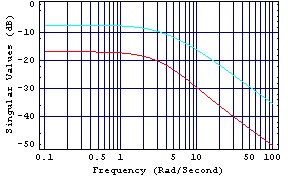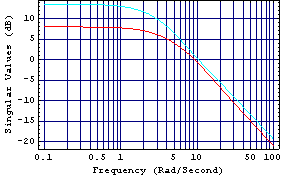A high-frequency aligning compensator can be determined for a multivariable system by using the function AligningCompensator. | AligningCompensator[system] |
|
| | determine an aligning compensator for the object system at zero frequency |
| AligningCompensator[system, w] |
|
| | determine an aligning compensator at the frequency w |
The AligningCompensator function. Make sure the application is loaded. Here is a two-input, two-output open-loop stable system. | Out[3]= |  |
The high-frequency interaction in the system can be determined by examining its singular value plots. 
The distance between the maximum singular value plot and the minimum singular value plot is a measure of the condition number of the system at each frequency considered. If these two plots can be made to coincide, then the system is diagonal and there is no interaction at any frequency. Here, you can see that at the low frequencies these plots are separated by some 9 dB, and at the high frequencies they are separated by some 15 dB. The choice of frequency at which the high-frequency compensator is determined is a compromise. This is the high-frequency aligning compensator for  = 10 rad/s. = 10 rad/s. | Out[6]= |  |
Applying this compensator to the system greatly reduces the amount of high-frequency interaction. 
This determines the transfer-function matrix of the resulting closed-loop system, with unity negative feedback. These are the poles of this closed-loop system, which is stable with the high-frequency compensator applied. | Out[11]= |  |
|